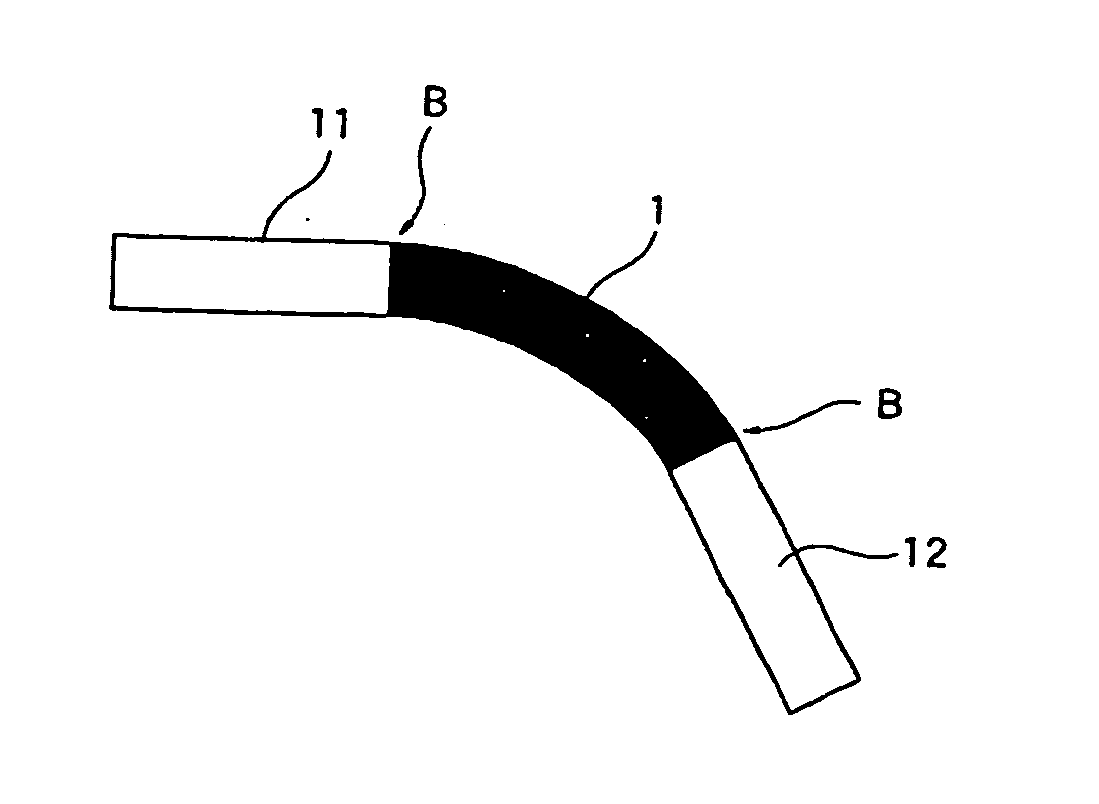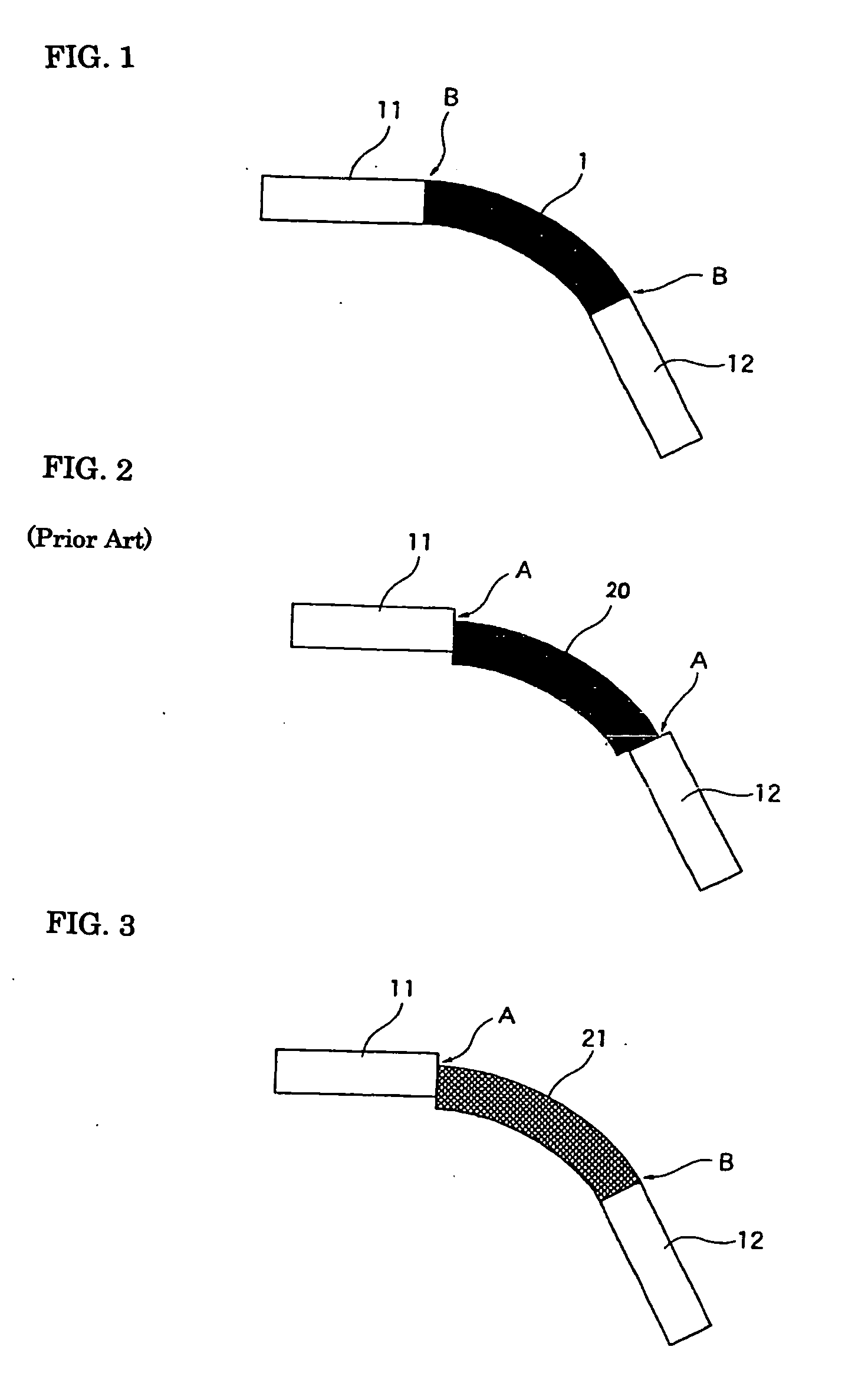Curved optical waveguide and optical device
a waveguide and optical technology, applied in the field of curved optical waveguides and optical devices, can solve the problems of inability to provide an optimum axial deviation amount in a wide wavelength range due to wavelength dependence, difficulty in forming infinite gaps in high yield, fluctuation in loss, etc., and achieves low loss, small variation upon production, and high yield.
- Summary
- Abstract
- Description
- Claims
- Application Information
AI Technical Summary
Benefits of technology
Problems solved by technology
Method used
Image
Examples
example 1
[0124] Evaluation about an excessive loss at a curved part in the present invention was performed as described below (input wavelengths of 1.31 μm and 1.55 μm).
[0125] The optical waveguides 1 to 4 of the first aspect of the invention each having a curve expressed by the function of the equation [II] as a central line were disposed by connecting as shown in FIG. 21. At this time, a length in a z-axis direction was 2.6775 mm, and a length in the direction perpendicular to a z-axis was 0.125 mm. To be specific, the resultant was enlarged or reduced in a z direction or x direction in such a manner that the equation [II] would be expressed in the form of the following equation [X]. Thus, the shape of an optical waveguide was obtained.
Trajectory of the central line of an optical waveguide:
x / height=z / length−sin [π(z / length)] / π [X]
where height=0.125 mm and length=2.6775 mm.
[0126] No offset was provided for every junction between middle and intervening sections. In addition, the optic...
example 2
[0133] Next, the excessive loss of a 1×8 splitter having a constitution shown in FIG. 22 was calculated. In the figure, the optical waveguide of the present invention having a curve represented by the function of the equation [II] was used in a section 1 expressed by a solid line, the optical waveguides of the present invention each having a curve represented by the function of the equation [III] were used in sections 2 to 10 expressed by solid lines, curved optical waveguides each shown in FIG. 6 and straight line-optical waveguides were used in sections 51 to 64 expressed by dotted lines, and multi-mode optical waveguides were used in sections 34 to 40. When the optical waveguides of the present invention were used for connection, an average excessive loss was −9.53 dB (for an input wavelength of 1.31 μm) or −9.76 dB (for an input wavelength of 1.55 μm). Next, for comparison, the excessive loss of a 1×8 splitter having a constitution similar to that shown in FIG. 22 was calculated...
example 3
[0136] An optical splitter having a curved optical waveguide having a schematic structure shown in FIG. 22 was produced by using the following materials.
Core: OPI-N3205 manufactured by Hitachi Chemical Co., Ltd.
Clad: OPI-N1005 manufactured by Hitachi Chemical Co., Ltd.
[0137] Production method; an organic zirconium chelate was applied by means of a spin coating method to a silicon wafer in which V grooves had been formed in such a manner that the chelate would have a thickness of 100 angstroms after drying. After the resultant had been dried, a polyimide resin free of fluorine was applied to the resultant in such a manner that the resin would have a thickness of 0.3 μm after drying. After the resultant had been dried, a lower clad layer (8 μm) and a core layer (6.5 μm) each composed of a polyimide resin containing fluorine were formed. Next, a silicon-containing resist was applied on the core layer to have a thickness of 0.5 μm, and was dried. The resultant was subjected to expo...
PUM
 Login to View More
Login to View More Abstract
Description
Claims
Application Information
 Login to View More
Login to View More - R&D
- Intellectual Property
- Life Sciences
- Materials
- Tech Scout
- Unparalleled Data Quality
- Higher Quality Content
- 60% Fewer Hallucinations
Browse by: Latest US Patents, China's latest patents, Technical Efficacy Thesaurus, Application Domain, Technology Topic, Popular Technical Reports.
© 2025 PatSnap. All rights reserved.Legal|Privacy policy|Modern Slavery Act Transparency Statement|Sitemap|About US| Contact US: help@patsnap.com



